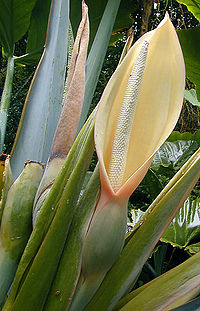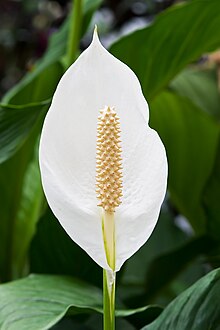Araceae are a family of monocotyledonous flowering plants in which flowers are borne on a type of inflorescence called a spadix. The spadix is usually accompanied by, and sometimes partially enclosed in, a 'spathe' or leaf-like bract.
| Arum family Temporal range: Upper Cretaceous (70 mya)[1] – Recent
| |
|---|---|

| |
| Flower of Xanthosoma sagittifolium | |
| Scientific classification | |
| Kingdom: | |
| Division: | |
| Class: | |
| Order: | |
| Family: | Araceae |
| Genera | |
|
See text. | |

Also known as the Arum family, members are often colloquially known as aroid. This family of 107 genera and over 3700 species is most diverse in the New World tropics, although also distributed in the Old World tropics and north temperate regions.
These plants often have rhizomes or tubers with calcium oxalate crystals or 'raphides' and commonly with milky sap. The leaves are alternate, simple or compound, petiolate, sometimes very large, and usually with a sheathing base.
Some genera of araceae include:
References
change- ↑ Bogner, Josef; Johnson, Kirk R.; Kvacek, Zlatko; Upchurch, Garland R. Jr (2007). "New fossil leaves of Araceae from the Late Cretaceous and Paleogene of western North America". Zitteliana. 47: 133–147.